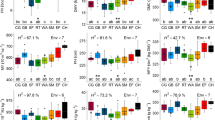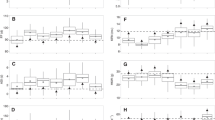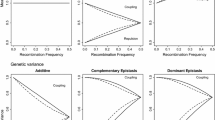Abstract
Single crosses (SC) of elite inbreds and open-pollinated populations (OP) are suitable source germplasm for doubled haploid (DH) line development in hybrid maize breeding, given that they combine a high population mean (\( \overline{x} \)) for testcross performance with adequate response to selection (\( \Updelta G \)). This is the first study reporting testcross grain yield (TCGY) and dry matter content (TCDMC) evaluations of 131 DH lines developed from ten tropical source germplasm comprising five OP (OP1–OP5) and five SC (SC1–SC5). Gene diversity (d) and the average number of alleles (a r ) per locus was estimated for DH lines based on 24 simple sequence repeat markers. Analysis across three environments revealed no significant differences between \( \overline{x} \) of OP- and SC-derived DH lines for TCGY and TCDMC. Significant genetic variance for both traits was only detected among OP-derived DH lines which may be explained by a larger number of segregating quantitative trait loci (QTL) as suggested by higher d and a r values than in SC-derived DH lines. The usefulness criterion (\( U = \overline{x} + \Updelta G \)) was higher for OP-derived DH lines for TCDMC, but higher for SC-derived DH lines for TCGY. DH lines from OP1, OP2, and OP3 showed high TCGY, suggesting that they may be useful in tropical hybrid breeding. We conclude that tropical OP represent a valuable source of untapped genetic variation that can efficiently be exploited with DH technology for hybrid maize breeding.


Similar content being viewed by others
Abbreviations
- CIMMYT:
-
International Maize and Wheat Improvement Center
- DH:
-
Doubled haploid
- OP:
-
Open-pollinated population(s)
- QTL:
-
Quantitative trait loci
- SC:
-
Single cross(es)
- SSR:
-
Simple sequence repeat
- TCDMC:
-
Testcross dry matter content
- TCGY:
-
Testcross grain yield
References
Bauman LF (1981) Review of methods used by breeders to develop superior corn inbreds. Proc Corn Sorgh Ind Res Conf 36:199–208
Bernardo R (2002) Breeding for quantitative traits in plants. Stemma Press, Woodbury
CIMMYT (1998) A complete listing of improved maize germplasm from CIMMYT. Maize Program Spec Rep, Mexico (DF)
CIMMYT (2005) Laboratory protocols: CIMMYT applied molecular genetics laboratory. CIMMYT, Mexico (DF)
Duvick DN, Smith JCS, Cooper M (2004) Long-term selection in a commercial hybrid maize breeding program. Plant Breed Rev 24:109–151
Falconer DS, Mackay TFC (1996) Introduction to quantitative genetics, 4th edn. Longmann Scientific & Technical, New York
Fountain MO, Hallauer AR (1996) Genetic diversity within maize breeding populations. Crop Sci 36:26–32
Gallais A (1990) Quantitative genetics of doubled haploid populations and application to the theory of line development. Genetics 124:199–206
Geiger HH (2009) Doubled haploids. In: Bennetzen JL, Hake S (eds) Maize Handbook, vol II., Genetics and Genomics, Springer Science and Business Media, New York, pp 641–657
Hallauer AR, Carena MJ, Miranda JB (2010) Quantitative genetics in maize breeding. Springer Science and Business Media, New York
Ho JC, Kresovich S, Lamkey KR (2005) Extent and distribution of genetic variation in U.S. maize: historically important lines and their open-pollinated dent and flint progenitors. Crop Sci 45:1891–1900
Hoisington D, Khairallah M, Reeves R, Ribaut J-M, Skovmand B, Taba S, Warburton M (1999) Plant genetic resources: what can they contribute toward increased crop productivity? PNAS 96:5937–5943
Kalinowski ST (2005) HP-RARE: a computer program for performing rarefaction on measures of allelic diversity. Mol Ecol Notes 5:187–189
Lamkey KR, Schnicker BJ, Melchinger AE (1995) Epistasis in an elite maize hybrid and choice of generation for inbred line development. Crop Sci 35:1272–1281
Lashermes P, Gaillard A, Beckert M (1988) Gynogenetic haploid plants analysis for agronomic and enzymatic markers in maize (Zea mays L.). Theor Appl Genet 76:570–572
Leberg PL (2002) Estimating allelic richness: effects of sample size and bottlenecks. Mol Ecol 11:2445–2449
Liu K, Muse SV (2005) PowerMarker: an integrated analysis environment for genetic marker analysis. Bioinformatics 21:2128–2129
Martin M, Miedaner T, Dhillon BS, Ufermann U, Kessel B, Ouzonova M, Schipprack W, Melchinger AE (2011) Colocalization of QTL for Gibberella ear rot resistance and low mycotoxin contamination in early European maize. Crop Sci 51:1935–1945
Melchinger AE (1987) Expectations of means and variances of testcrosses produced from F2 and backcross individuals and their selfed progenies. Heredity 59:105–115
Melchinger AE, Schmidt W, Geiger HH (1988) Comparison of testcrosses produced from F2 and first backcross populations in maize. Crop Sci 28:743–749
Melchinger AE, Longin CF, Utz HF, Reif JC (2005) Hybrid maize breeding with doubled haploid lines: quantitative genetic and selection theory for optimum allocation of resources. In: Proc. of the 41st Annual Illinois Corn Breeders School 2005, Urbana-Champaign, IL. 7-8 Mar. 2005. Univ. of Illinois at Urbana-Champaign, pp 8-21
Mikel MA, Dudley JW (2006) Evolution of North American dent corn from public to proprietary germplasm. Crop Sci 46:1193–1205
Ortiz R, Taba S, Chávez Tovar VH, Mezzalama M, Xu Y, Yan J, Crouch JH (2010) Conserving and enhancing maize genetic resources as global public goods - a perspective from CIMMYT. Crop Sci 50:13–28
Pacheco CAP, Dos Santos MX, Cruz CD, Parentoni SN, de Oliveira Guimarães PE, Comes e Gama EE, da Silva AE, Lemos de Carvalho HW, Vieira Júnior PA ((2002)) Inbreeding depression of 28 maize elite open pollinated varieties. Genet Mol Biol 25:441–448
Perrier X, Jacquemoud-Collet JP (2006) DARwin software. http://darwin.cirad.fr/darwin
Piepho H-P (2004) An algorithm for a letter-based representation of all-pairwise comparisons. J Compt Graph Stat 13:456–466
Piepho HP, Büchse A, Emrich K (2003) A hitchhiker’s guide to mixed models for randomized experiments. J Agron Crop Sci 189:310–322
Piepho H-P, Williams ER, Fleck M (2006) A note on the analysis of designed experiments with complex treatment structure. Hortic Sci 41:446–452
Pixley KV, Bänziger M (2004) Open-pollinated maize varieties: a backward step or valuable option for farmers? In: Friesen DK Palmer AFE (eds) Integrated approaches to higher maize productivity in the new millennium. Proc. of the 7th Eastern and Southern Africa Regional Maize Conf., Nairobi, Kenya. 5-11 Feb. 2002, pp 22-29
Pollak LM (2003) The history and success of the public-private project on germplasm enhancement of maize (GEM). Adv Agron 78:45–87
Prigge V, Melchinger AE (2012) Production of haploids and doubled haploids in maize. In: Loyola-Vargas VM and Ochoa-Alejo N (eds) Plant cell culture protocols. Third edition. Humana Press - Springer Verlag, Totowa, New Jersey, (in press)
Prigge V, Sánchez C, Dhillon BS, Schipprack W, Araus JL, Bänziger M, Melchinger AE (2011) Doubled haploids in tropical maize: I. Effects of inducers and source germplasm on in vivo haploid induction rates. Crop Sci 51:1498–1506
Reif JC, Hamrit S, Heckenberger M, Schipprack W, Maurer HP, Bohn M, Melchinger AE (2005) Trends in genetic diversity among European maize cultivars and their parental components during the past 50 years. Theor Appl Genet 111:838–845
Röber FK, Gordillo GA, Geiger HH (2005) In vivo haploid induction in maize - performance of new inducers and significance of doubled haploid lines in hybrid breeding. Maydica 50:275–283
Rogers JS (1972) Measures of genetic similarity and genetic distance. In: Studies in genetics VII. Publ. 7213. University of Texas, Austin, pp 145-153
SAS Institute (2008) SAS Version 9.2. SAS Institute, Cary, NC
Schnell FW (1983) Probleme der Elternwahl - ein Überblick. (in German) In: Arbeitstagung der Vereinigung der Saatzuchtleiter in Gumpenstein, Austria, 22.–24. Nov., Verlag und Druck der Bundesanstalt für alpenländische Landwirtschaft. Gumpenstein, Austria (The problems of parental selection - an overview. Proceedings of the Annual Meeting of the Austrian Seed Association, Gumpenstein, Austria, 22.–24. Nov. Gumpenstein, Austria)
Seitz G (2005) The use of doubled haploids in corn breeding. In: Proc. of the 41st Annual Illinois Corn Breeders School 2005, Urbana-Champaign, IL. 7-8 Mar. 2005. Univ. of Illinois at Urbana-Champaign, pp 1-7
Smith JSC, Hussain T, Jones ES, Graham, Podlich D, Wall S, Williams M (2008) Use of doubled haploids in maize breeding: implications for intellectual property protection and genetic diversity in hybrid crops. Mol Breed 22:51–59
Warburton ML, Reif JC, Frisch M, Bohn M, Bedoya C, Xia XC, Crossa J, Franco J, Hoisington DA, Pixley K, Taba S, Melchinger AE (2008) Genetic diversity in CIMMYT nontemperate maize germplasm: landraces, open pollinated varieties, and inbred lines. Crop Sci 48:617–624
Wilde K, Burger H, Prigge V, Presterl T, Schmidt W, Ouzunova M, Geiger HH (2010) Testcross performance of doubled-haploid lines developed from European flint maize landraces. Plant Breed 129:181–185
Acknowledgments
We dedicate this paper to Dr. Suketoshi Taba, maize genetic resources specialist and head of CIMMYT’s maize germplasm collection for many years, on the occasion of his retirement. We greatly appreciate the donation of DH lines from OP2-OP5 by KWS SAAT AG, Germany. Further, we thank Ing. Ciro Sánchez and co-workers at CIMMYT’s experimental stations and Dr. Mauro Sierra and co-workers at INIFAP, Cotaxtla for their skilled technical assistance in field experimentation. Vanessa Prigge gratefully acknowledges the financial support by the Eiselen Foundation Ulm, Germany for her research as a joint Ph.D. student between CIMMYT and the University of Hohenheim, Germany. The financial support provided by the Bill and Melinda Gates Foundation, Seattle, WA, USA, through the Drought Tolerant Maize for Africa (DTMA) project is gratefully acknowledged.
Author information
Authors and Affiliations
Corresponding author
Electronic supplementary material
Below is the link to the electronic supplementary material.
10681_2012_626_MOESM1_ESM.pdf
Supplemental Fig. 1. Joint unweighted neighbor-joining dendrogram based on Rogers’ distance determined with 24 simple sequence repeat markers on doubled haploid lines developed from five open-pollinated populations (green) and five elite single crosses (blue). For pedigrees of groups see Table 1. (PDF 37 kb)
Rights and permissions
About this article
Cite this article
Prigge, V., Babu, R., Das, B. et al. Doubled haploids in tropical maize: II. Quantitative genetic parameters for testcross performance. Euphytica 185, 453–463 (2012). https://doi.org/10.1007/s10681-012-0626-z
Received:
Accepted:
Published:
Issue Date:
DOI: https://doi.org/10.1007/s10681-012-0626-z




